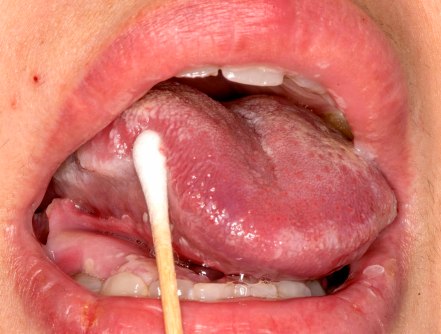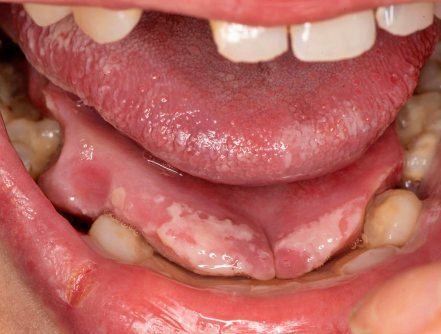Urgent Message: Patients may present to an urgent care facility with intraoral angioedema, a life-threatening emergency that requires referral to an emergency department in any case with rapid progression or concerns for airway involvement. This case report describes angioedema from olanzapine, an antipsychotic prescription drug.
Chantelle Petterson, BDS, Benjamin Fu, MD, BDSc (HONS), MPhil, FRACDS (OMS)
Citation: Petterson C, Fu B. Intraoral Angioedema After Olanzapine Overdose: A Case Report. J Urgent Care Med. 2024; 18(9):34-36
Key Words: angioedema, olanzapine, overdose, case report
Abstract
Introduction: Angioedema is swelling of the deeper layers of the skin or mucosa and is often related to an allergic reaction. It commonly presents in the face and oral cavity with the most severe complication being airway obstruction. Olanzapine is an atypical antipsychotic medication. There have been multiple case reports of angioedema related to olanzapine, as well as other atypical antipsychotic medications, previously reported in the literature.
Clinical presentation: A generally healthy 30-year old female presented to a rural medical center with significant tongue and floor of mouth swelling after unintentional overdose on the olanzapine prescribed by her general physician. Her airway was patent at the time of her presentation. She also had a new orofacial twitch and stuttering speech. No other precipitating causes of the patient’s symptoms were identified.
Case resolution: The patient was transferred to an urban hospital where she was treated for possible anaphylactic type reaction as well as for likely tardive dyskinesia. After the patient’s airway was deemed safe, she was discharged for outpatient follow-up. At the time of follow-up, she had complete resolution of her symptoms and swelling.
Conclusion: While not commonly reported, antipsychotic medications may lead to oral angioedema. Angioedema can lead to airway impingement, and immediate referral to an emergency department (ED) is indicated if there is any concern for impending compromise of the airway.
Introduction
Olanzapine is a second-generation atypical antipsychotic drug commonly prescribed for treatment of schizophrenia and other psychotic conditions. The olanzapine medication datasheet reports drug related adverse reactions of angioedema very rarely (<0.01%) and dyskinesia commonly (>1%–10%).1 Angioedema refers to the restricted swelling of subcutaneous or mucous membranes that occurs most commonly as an allergic response. Frequent causes include insect bites/stings, medications, and foods. Angioedema commonly affects the face and oral cavity with the most severe complication being airway obstruction.2
Angioedema secondary to antipsychotic medication has been described in several case reports previously published in the literature. Case reports describing angioedema reactions secondary to antipsychotic medication include those related to trifluoperazine,3 haloperidol,4,5 and respiradone.6,7 Olanzapine has also been implicated in several reported cases with more widespread edema8,9 and in a post-marketing surveillance study.10 Because patients may present to an urgent care (UC) facility with this issue, it is important that clinicians are aware of antipsychotic prescription medication as a possible precipitant for what otherwise may be deemed idiopathic angioedema.
Case Report
A 30-year-old female who was otherwise healthy presented to a rural medical center with sublingual swelling and orofacial/tardive dyskinesia, thought initially to be caused by a dental infection. Her sublingual swelling began 10 days prior. She had seen her primary care physician with symptoms of psychological distress prior to her symptoms beginning and was prescribed oral olanzapine 10mg daily. However, the patient did not take the medication as prescribed and reported taking up to 40mg at a time on at least 1 occasion. She had no known allergies, and this was her first time being exposed to the medication.
Clinical Findings
On physical examination, the patient was afebrile and had normal vital signs. She had generalized fullness in the submental region bilaterally, a notable orofacial twitch and a verbal tic, best characterized as stuttering. She had no drooling, stridor, or other signs of airway compromise. Her tongue and floor of mouth were elevated with prominent sublingual glands (Figure 1, 2). There was no purulence seen intraorally, and no teeth were tender or mobile.


Urgent Care Management
The patient was then referred to the emergency department at the regional urban referral center in New Zealand where she was seen by an oral and maxillofacial surgery (OMFS) specialist.
Diagnostic Assessment
On laboratory evaluation, the C-reactive protein level was normal (<1mg/L) as were the remainder of the blood tests, apart from mild leukocytosis. A dental panoramic radiograph and a computer tomography (CT) scan with contrast were obtained, which did not show evidence of deep space infection or periapical dental disease. The OMFS specialists, in collaboration with review by neurology, psychiatry, and general medicine specialty teams, concluded that the diagnosis was allergic angioedema secondary to olanzapine overdose.
Therapeutic Intervention and Outcomes
The patient was admitted for monitoring. The psychiatry team recommended discontinuing olanzapine and initiated a series of benztropine intramuscular (IM) injections over a period of 48-hours to treat her dyskinesia. Oral benztropine was continued for 2 weeks after hospital discharge. She was prescribed a benzodiazepine, lorazepam, in lieu of any further antipsychotic medication for her ongoing mental health symptoms. Once her airway risk was deemed to be resolved, she was discharged. At an outpatient telehealth follow-up visit, her dyskinesia, verbal difficulties, and swelling had all fully resolved.
Discussion
Olanzapine is an atypical antipsychotic medication that was approved by the U.S. Food and Drug Administration for the treatment of bipolar disorder and schizophrenia in the late 1990s.11 Although the patient did not have a diagnosis of these conditions, she was prescribed olanzapine and did not take the medication as instructed, but rather at significantly higher doses. Olanzapine, like other several other antipsychotic medications, appears to be capable of triggering angioedema,4,5,8 although this is the only known case report of olanzapine as a single agent causing predominantly oral angioedema.
The frequency of angioedema associated with antipsychotic medications appears to be low.10 It is unclear if the inappropriately high dosing may have contributed to an increased risk of angioedema in this case. It is, however, likely that the patient’s tardive dyskinesia was related to the supratherapeutic dosing.
Dyskinesia and other extrapyramidal symptoms (EPS) caused by antipsychotic medications occur less frequently with the atypical antipsychotics, such as olanzapine, than with first-generation antipsychotics (eg, haloperidol). However, dose escalation has been associated with an increased risk of EPS, even with the atypicals.12 Unlike other forms of EPS, in the majority of cases, tardive dyskinesia is a permanent condition and does not resolve after withdrawing the medication.13
Fortunately, the patient’s swelling and EPS resolved in this case, and airway intervention was not needed. However, it is important for UC clinicians to be aware of the medications that can trigger serious reactions, even if rare, so that they may be discontinued and patients may be counseled to avoid them again in the future.
Ethics Statement
The patient gave consent for the publication of this case. She encouraged her story and photographs to be shared in order to help clinicians to help patients with similar conditions.
Takeaway Points
- Having familiarity with the common and uncommon adverse reactions to medications is an important knowledge base to hone for UC clinicians.
- While angioedema secondary to antipsychotic medication use is uncommon, patients may present to UC facilities with intraoral swelling without a clear alternative etiology.
- Due to the risk of airway compromise when oral angioedema occurs, it is crucial for clinicians to be familiar with escalation pathways and local hospital specialist availability to ensure such patients are referred to centers capable of managing the airway when there is oral swelling.
Manuscript submitted September 25, 2023; accepted April 24, 2024.
References
- Pharmco N.Z. Ltd. Zyprexa data sheet 1997. Revised 2023. Available at: https://medsafe.govt.nz/profs/datasheet/z/zyprexatabzyprexazydiswafer.pdf.
- Long BJ, Koyfman A, Gottlieb M. Evaluation and Management of Angioedema in the Emergency Department. West J Emerg Med. 2019 Jul;20(4):587-600.
- Osman M, Edwards D, Kilduff M. Trifluoperazine-induced angioedema. Case Rep Psychiatry. 2014;2014:140329.
- Strain A. Angioedema of the tongue due to haloperidol. Am J Emerg Med. 2022 Mar;53:284.e5-284.e6.
- AlMadhyan AB. Angioedema associated with haloperidol. Int J Health Sci (Qassim). 2015 Jan;9(1):76-8.
- Güneş F, Batgi H, Akbal A, Canatan T. Angioedema – an unusual serious side effect of risperidone injection. Clin Toxicol (Phila). 2013 Feb;51(2):122-3.
- Samra GS, Kant S, Chow R. Risperidone induced angioedema with concurrent EPS symptoms: a case report and review of literature. J Community Hosp Intern Med Perspect. 2018 Apr 17;8(2):80-83.
- Cook EA, Shipman D, Fowler TG. Whole-body edema with olanzapine: A case report and literature review. Ment Health Clin. 2020 Sep 30;10(5):291-295.
- Tatar ZB, Oflaz S, Baran B. A case of late-onset angioedema associated with clozapine and redevelopment of angioedema with olanzapine. J Clin Psychopharmacol. 2014 Aug;34(4):523-5.
- Biswasl PN, Wilton LV, Pearcel GL, Freemantle S, Shakir SA. The pharmacovigilance of olanzapine: results of a post-marketing surveillance study on 8858 patients in England. J Psychopharmacol. 2001 Dec;15(4):265-71.
- Food and Drug Administration Prescribing Information for Olanzapine. Accessed at: https://www.accessdata.fda.gov/drugsatfda_docs/label/2010/020592s057,021086s036,021253s045lbl.pdf.
- Farah A. Atypicality of atypical antipsychotics. Prim Care Companion J Clin Psychiatry. 2005;7(6):268-74.
- Kiriakakis V, Bhatia KP, Quinn NP, Marsden CD. The natural history of tardive dystonia. A long-term follow-up study of 107 cases. Brain. 1998 Nov;121 ( Pt 11):2053-66.
Read More
Author Affiliations: Chantelle Petterson, BDS, Waikato Hospital, New Zealand. Benjamin Fu, MD, BDSc (HONS), MPhil, FRACDS (OMS), Oral and Maxillofacial Surgery Department, Waikato Hospital, Te Whatu Ora, New Zealand. Authors have no relevant financial relationships with any ineligible companies.
